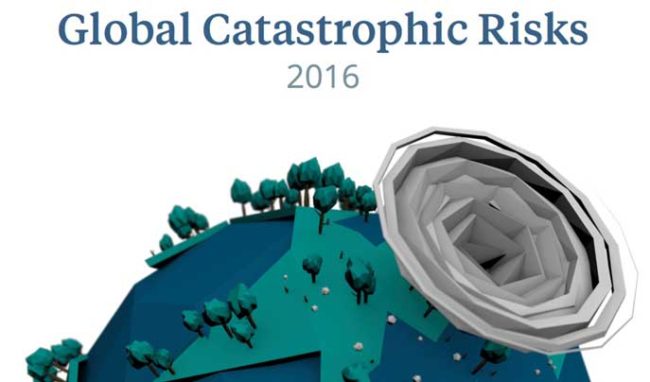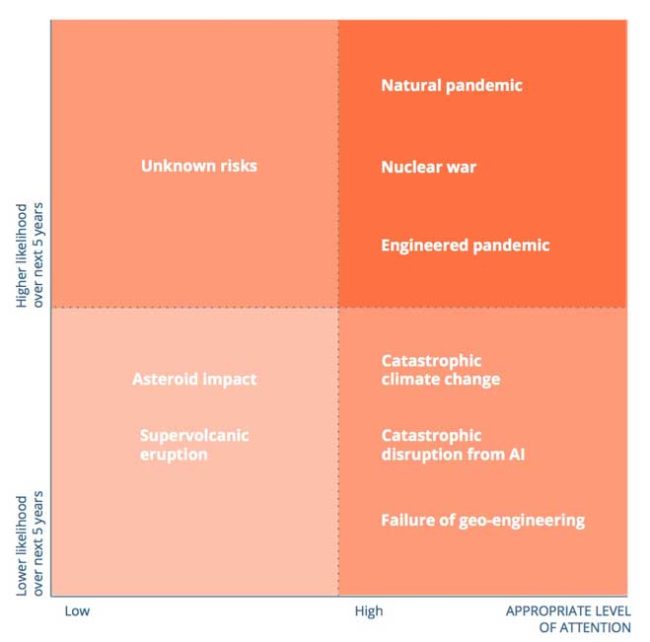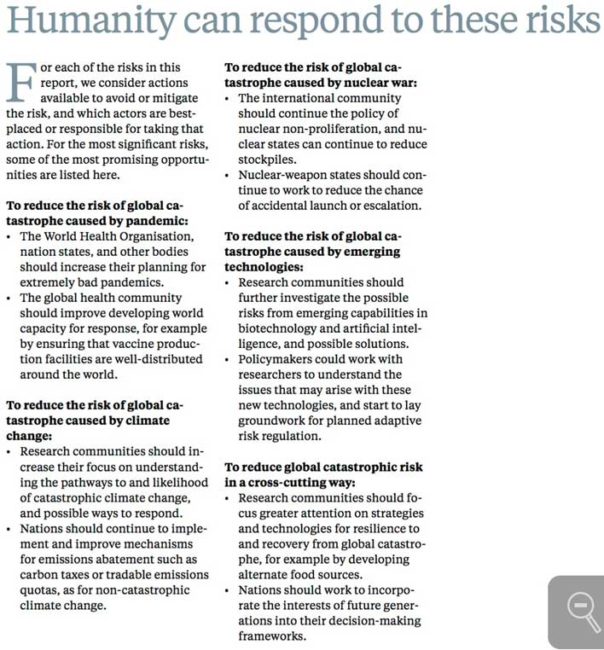 The 2016 Global Catastrophic Risks report is out. This is an annual report issued by the Global Challenges Foundation and as you might imagine it has stirred up a few rather lurid headlines within some media outlets, for example the Daily Mail rolls with …
The 2016 Global Catastrophic Risks report is out. This is an annual report issued by the Global Challenges Foundation and as you might imagine it has stirred up a few rather lurid headlines within some media outlets, for example the Daily Mail rolls with …
‘Apocalypse’ report warns killer robots, asteroids or global pandemics could wipe out humanity in the next five years
It may be worth nothing that the primary focus of the foundation is climate change and other similar environmental factors, and that the high risk items in the report is neither asteroids, nor killer robots.
OK, so who exactly are these guys and what drives them?
Their “About Us” link explains …
The Global Challenges Foundation, based in Stockholm, Sweden, was founded in 2012 by the former financier Laszlo Szombatfalvy. The origin was the ideas he proposed in his book The Greatest Challenges of Our Time (Ekerlids Publishing House, 2010). In this book he expounded his view of risk and risk management – which he used with great success in his own portfolio management – and expanded this perspective to also include global risks.
… Among more recent projects is the first compilation of the world’s greatest global risks, which was conducted in cooperation with the Future of Humanity Institute at Oxford University
The basic premise behind it all is that if you consider the formula …
risk = potential future damage x probability of occurrence
… the even if the probability of a specific event is very very low (killer robots), if the potential for damage is very high, then the risk is actually high.
So they now publish this annual Global Risks report in conjunction with the Global Priorities Project at Oxford Martin School at Oxford University. In fact, starting next July, they have decided to ramp that up and have quarterly reports. Oh boy are the media going to love these guys.
What actual Risks do they identify?
Well, here is how they slice and dice things, and upon first glance, yes, I think this is indeed about right.
 Notice that within the above grid the risk within the top righthand corner is “Natural Pandemic”, and this is perhaps indeed most probably the highest risk we as a species face.
Notice that within the above grid the risk within the top righthand corner is “Natural Pandemic”, and this is perhaps indeed most probably the highest risk we as a species face.
We often forget what has happened. The First World war was truly devastating, millions died. To be precise, between the years 1914 and 1918 ….
The total number of military and civilian casualties in World War I was more than 38 million: there were over 17 million deaths and 20 million wounded, ranking it among the deadliest conflicts in human history.
… and so we strive to never forget this war to end all wars (as it was labelled by some), and so within the UK, almost every village and town has a monument of remembrance, and ever November we stand and pause for a few minutes to remember.
But something else happened in 1918, and it is something we forget, push away from cultural memory and so we are not as conscious of it. It impacted 500 Million people, and killed about 50 million. Yes for every single individual who died in WWI, in a single six month period in 1918, something killed almost twice that number, and we tend to forget.
It was Flu, in 1918, the particular strain of flu that year mutated into a variation that was lethal to humans, and millions upon millions died. At the time more than 25% of the US population became sick. It led to the death of something between 2.5-5% of the entire world population
Victims died within hours or days of their symptoms appearing, their skin turning blue and their lungs filling with fluid that caused them to suffocate. In just one year, 1918, the average life expectancy in America plummeted by a dozen years.
…One unusual aspect of the 1918 flu was that it struck down many previously healthy, young people–a group normally resistant to this type of infectious illness–including a number of World War I (1914-18) servicemen. In fact, journalist Gina Kolata has reported that more U.S. soldiers died from the 1918 flu than were killed in battle during the war. Forty percent of the U.S. Navy was hit with the flu, while 36 percent of the Army became ill, notes Kolata in her book on the subject.
Although the death toll attributed to the 1918 flu is often estimated at 20 million to 50 million victims worldwide, other estimates run as high as 100 million victims.
That 1918 Spanish Flu was not a unique event, the Great Plague of Justinian wiped out about 17% of the entire human population on the planet.
So my point is this. If you are worried about killer robots or deep impact asteroids (as the Daily Mail suggests) then you are worrying about the wrong things, the highest impact / most probable global risk we face is a “Natural Pandemic”.
Responding to Risks
The report is in many ways a useful tool, because if we understand the risks we face, the we can plan and take steps to mitigate such risks.
Here are some examples they suggest for the various risks they highlight …
Nobody plans to have their house or office burn down, but thinking the unthinkable is very wise, and so having a smoke alarm, fire wardens, and fire drills enables us to not just cope, but to potentially survive. Such thinking need not prevail at just that level, and so that is the motivation behind the Global Challenges Foundation, it is not just a source for doom-mongering media headlines about the T2 coming to get us, but rather is about inspiring us to start thinking about how to prepare to respond to potential risks.
As for the report itself, it is worth a read and is quite readable.

